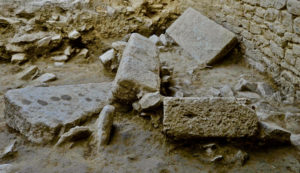
The Peloponnese, Greece—About 3,500 years had passed before anyone seriously laid hands on the stones that defined the upper reaches of the tombs. Hidden below grape vines in a field not far from the remains of the ancient palace of the mythological and legendary King Nestor himself, most visitors walking along this elevated vista overlooking the Mediterranean Sea in southern Greece would never have suspected the significance of what lay buried beneath their feet.
But a team of archaeologists knew the potential of the field. As is typical at the beginning of any excavation or survey, they began clearing the surface of vegetation — not a particularly enjoyable start. The team consisted of director archaeologists Jack Davis and Sharon Stocker, along with a group of student volunteers, from the University of Cincinnati.
Vegetation notwithstanding, the most arduous task was actually still to come. “There were noticeable concentrations of rocks on the surface once we got rid of the vegetation,” said Stocker.* These were watermelon-sized stones.
And there were thousands.
They were the remains of collapsed beehive-shaped (tholos) tombs the ancients constructed at this location millennia ago, during the Late Bronze Age. In the spirit and style of archaeology, the team removed them carefully one at a time. The painstaking work eventually revealed two tombs, one of them as deep as nearly 15 feet below the surface. “It was like going back to the Mycenaean Period. They had placed them by hand in the walls of the tombs and we were taking them out by hand,” Stocker said.*
Like a Gold Mine……..
Their work soon began to pay off. “By the end of the first week we knew we had something that was really important,” said Stocker.* And the finds were remarkable. These were clearly princely tombs. Excavations yielded “thousands of small pieces of gold foil, beads, pieces of faience, small bits of bronze and the occasional piece of silver”, according to Stocker; and though they did not give up intact bronze vessels and weaponry as was the case in the nearby ‘Griffin Warrior’ tomb, also excavated by a team led by Davis and Stocker in 2015 (see below), they did yield an agate sealstone emblazoned with two genii (mythological lion-like creatures), a gold ring featuring two bulls flanked by sheaves of barely grain, and a gold pendant showing what could be the Egyptian goddess Hathor. These finds, along with the small fragments of gold foil and other small artifact fragments, clearly suggested wealth and status. Some news releases reported that the gold foil indicated the walls had once been covered in gold leaf. But “there is no evidence that the tomb walls were actually covered with gold leaf,” says Stocker. “[Carl] Blegen speculated as much, based on the quantity of gold leaf that was found in Tholos IV, which was excavated by his team member, Lord William Taylour, in 1953”. (Blegen, a Classics professor also with UC, was known for his excavation of the now famous remains of the nearby ‘Palace of Nestor” in 1939. See below.) Nonetheless, the finds and materials clearly point to tombs that once interred individuals or families of singular wealth and/or status, as well as a capacity to carry out a broad network of trade relationships in the Eastern Mediterranean — materials included amber from the Baltic, amethyst from Egypt, and imported carnelian, for example. The researchers employed extensive use of photogrammetry and digital mapping to record and document in detail the location and orientation of all objects within the tombs. This was important, according to director Davis, as it afforded the ability to “see all levels as we excavated them and relate them one to the other in three dimensions,” essential for analyzing, understanding and interpreting the tombs and the significance and meaning of their contents.*
Any scholar familiar with the archaeological remains of this region would say, however, that a more complete understanding of these newly excavated tombs has to take into account the larger context within which the tombs were found — Pylos.
Unearthing Ancient Pylos
…….we went to Pylos and to Nestor, the shepherd of the people, and he received me in his lofty house and gave me kindly welcome, as a father might his own son who after a long time had newly come from afar: even so kindly he tended me with his glorious sons…….
The words of Telemachus, the son of Odysseus and Penelope as penned by Homer in Book 17 of the Odyssey give us this ancient literary glimpse of Pylos, where the legendary King Nestor made his domicile. But beyond Homer the excavations over the last century have revealed a tangible place — a Pylos that can actually be seen and touched, verifying the historicity of the legendary place.
Evidence for human settlement at Pylos extends as far back as the Neolithic, though it is best known as an important center during Mycenaean times (1600 -1100 BC). Pylos as a state extended over 2,000 square kilometers (770 sq mi) with a population that may have ranged from 50,000 to as many as120,000 people. In 1939, a joint Hellenic-American expedition was formed with the Greek Archaeological Service under Epano Englianos and Carl Blegen with the University of Cincinnati. Excavations began on 4 April 1939, with dramatic results. Almost immediately, stone walls, fresco fragments, Mycenaean pottery and inscribed tablets were unearthed. Blegen identified monumental structural remains as the great “Palace of Nestor”, and although it is not certain that this was indeed such, Linear B tablets found during the excavations indicated that the site in which the structure is located was anciently called Pylos. In fact, about 1,000 Linear B tablets were unearthed. Translation of the tablets confirmed that they were part of a royal archive, and that the palace functioned as the administrative, political and financial center of the Mycenaean region of Messenia.
From 1952 to 1966, yet more of the Palace was uncovered, including areas identified to be part of the acropolis. Evidence attests to the conclusion that Pylos was abandoned at some point after the 8th century BC and ended in a fiery conflagration.
_______________________________
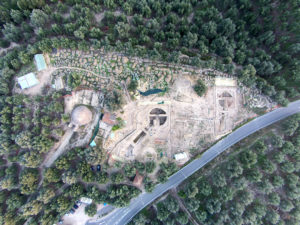
Aerial view showing the Tholos IV tomb, far left, found by UC archaeologist Carl Blegen in 1939 in relation to the two family tombs called Tholos VI and Tholos VII, recently excavated by UC archaeologists Jack Davis and Sharon Stocker. Denitsa Nenova/Courtesy Department of Classics, University of Cincinnati
_______________________________
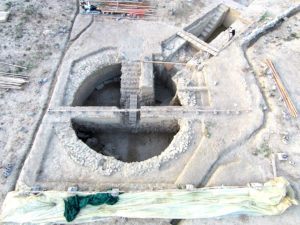
Aerial view of one of the recently excavated tombs, Tholos VI. Denitsa Nenova/Courtesy Department of Classics, University of Cincinnati
_______________________________
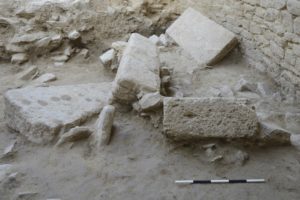
The floor of Tholos VI, featuring giant stone slabs (ashlars) likely removed from the remains of the nearby Palace of Nestor. Courtesy Department of Classics, University of Cincinnati
_______________________________

Carnelian sealstone featuring two mythological creatures called genii, which are lionlike mythological creatures, holding serving vessels and an incense burner over an altar beneath a 16-pointed star. Jeff Vanderpool/Courtesy Department of Classics, University of Cincinnati
_______________________________
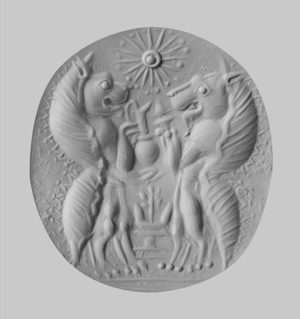
A modern putty impression of the carnelian seal stone. Jeff Vanderpool/Courtesy Department of Classics, University of Cincinnati
_______________________________
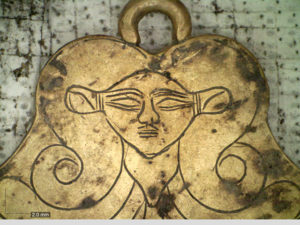
Gold pendant found in the family tombs, featuring the likeness of Hathor, an Egyptian goddess who protected the dead. Vanessa Muro/Courtesy Department of Classics, University of Cincinnati
_______________________________
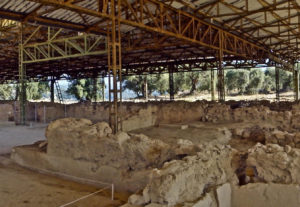
Above and below: The covered area of Nestor’s Palace. Fæ, Creative Commons Attribution-Share Alike 3.0 Unported license, Wikimedia Commons
_______________________________
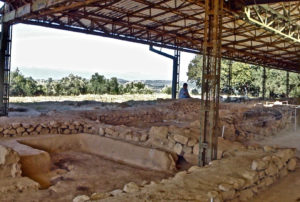
Fæ, Creative Commons Attribution-Share Alike 3.0 Unported license, Wikimedia Commons
_______________________________
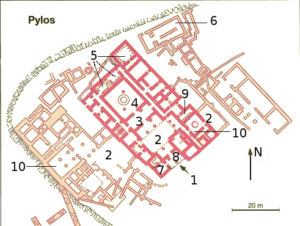
Plan of the excavated remains of the Palace of Nestor. 1-Entrance. 2-Court. 3-Anchamber. 4-Megaron(main hall). 5-Storerooms with olive oil. 6-Storerooms with wine. 7-Archives. 8-Propylon. 9-Bath. 10-Small megaron. Janmad, Creative Commons Attribution-Share Alike 4.0 International , Wikimedia Commons
_______________________________
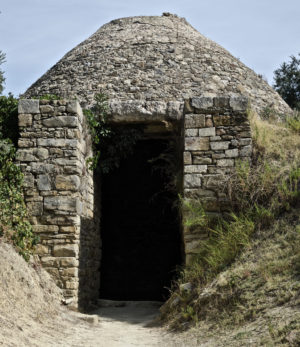
Tholos tomb IV at the Palace of Nestor site, built ca. 1550-1500 BC. Excavated by Blegen. Peulle, Wikimedia Commons, Creative Commons Attribution-Share Alike 4.0 International
_______________________________
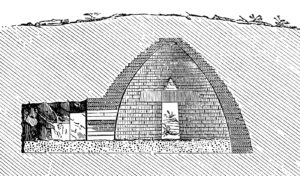
This cross section drawing of the Treasury of Atreus typifies a tholos (beehive) tomb.
_______________________________
The Griffin Warrior Tomb
Arguably one of the most remarkable discoveries at Pylos emerged in 2015, as an archaeological team headed by Davis and Stocker (University of Cincinnati) were excavating what appeared at first to be an otherwise unremarkable stone-lined shaft tomb. This description changed very quickly, however, as they began to encounter relatively intact objects made of bronze. Their efforts eventually led to the skeletal remains of an adult male and nearly 1500 artifacts, some of the artifacts featuring rich iconography, and all associated with a single burial. Dated to about 1500 B.C. based on pottery shards found at the location, the shaft tomb and its contents have turned out to be, according to Stocker, “one of the most magnificent displays of prehistoric wealth discovered in mainland Greece in the past 65 years.”** Stocker would know—after years of experience investigating an area rich with evidence of an ancient presence long before the classical Greeks, she had never personally encountered a single burial quite like this one.
The inventory of finds was astounding. As reported by M.B. Reilly of the University of Cincinnati in the related UC Magazine article, the object tally included the following:
The skeleton of an adult male, age approximately 30 – 35 years who would have stood about five-and-a-half feet tall, placed upon his back when buried;
At his left chest, a sword, three feet in length, featuring an ivory hilt decorated with gold in an embroidery design;
Beneath the sword, a small dagger featuring a similarly designed gold hilt;
More bronze weapons laying at his legs and feet;
Four solid gold seal finger rings;
A 30-inch long necklace of box-shaped gold wires with two gold pendants decorated with ivy leaves;
Numerous well-preserved gold beads;
Two gold cups and six silver cups, one with a gold rim;
Bronze cups, bowls, amphora, jugs, and a basin;
More than 50 seal stones featuring intricate carvings of goddesses, altars, reeds, lions, bulls – some with human bull jumpers flying over their horns. All seal stones were in Minoan style and likely originated in Crete;
Pieces of carved ivory, one featuring a griffin with large wings and another showing a lion attacking a griffin;
Six ornate ivory combs, implying that he may have had long hair;
Over 1,000 beads of carnelian, amethyst, jasper and agate. Archaeologists suggest that some of the beads may have decorated a fabric burial shroud – as suggested by several square inches of associated woven threads;
Thin bands of bronze, likely from long decayed body armor; and
Wild boar’s teeth, likely from a warrior’s helmet.**
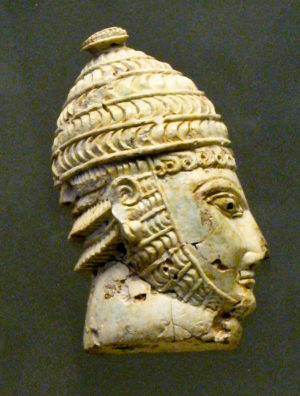
From a Mycenaean chamber tomb, elephant tooth warrior head wearing boar tusk helmet. Sharon Mollerus, Wikimedia Commons, Attribution 2.0 Generic License
From analysis of the burial, archaeologists could see that many of the burial objects were originally placed above the interred on top of his wooden coffin, which had been initially crushed by a fallen one-ton stone (likely the cap stone of the burial), the wooden coffin having long since decayed and collapsed and leaving the objects resting upon the skeleton. Further analysis of the skull indicated that he had a broad face with close-set eyes and a strong jaw.
The skeletal remains within the context of these finds clearly suggested the burial of a high status individual, perhaps even a king, or wanax, as Mycenaean kings or lords were called anciently. The man represented by the remains has been dubbed the “griffin warrior” by Davis and Stocker based on the griffin iconography and weaponry and armor found in the tomb.
More than a year later, conservationists in the lab revealed another stunning find from the tomb. After meticulous cleaning of a limestone-encrusted seal stone, they exposed an intricately detailed etching of a combat scene on a hard stone measuring only 3.6 centimeters, 1.4 inches, in length. In fact, many of the fine details become clear only when revealed through photomicroscopy.
“Some of the details on this are only a half-millimeter big,” said Davis. “They’re incomprehensibly small.”***
The image on the stone portrayed a warrior in the process of defeating two opponents, one already laying dead at his feet, and in the act of plunging a sword into the neck of the shielded second opponent — a scene of Achaean combat that could be likened to any event from the pages of Homer’s Iliad.
___________________________

Viewed from above, the excavated Griffin Warrior Tomb, with the one-ton capstone which dominated the scene of the tomb details during the excavation. Courtesy Department of Classics, University of Cincinnati
___________________________
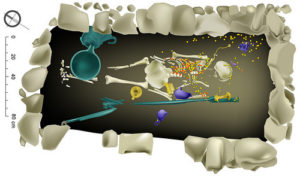
Graphic illustration of the shaft tomb, showing the spatial relationships of the various artifacts with the skeletal remains found within the tomb. Archaeologists noted that weapons had been placed on the left side of the body at burial while items such as the seal stones and rings were placed on the right. They also noted that some of the images represented on the rings correlated with actual artifacts within the tomb. Davis and Stocker hypothesize that these patterns suggest some purposeful intent at the time the body was interred. Denitsa Nenova, Courtesy Department of Classics, University of Cincinnati
___________________________
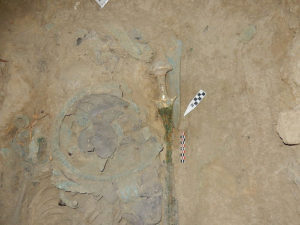
Above and below: The three-foot sword found next to the skeletal remains. Courtesy Department of Classics, University of Cincinnati
___________________________
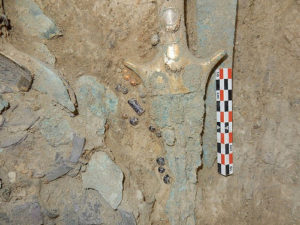
___________________________
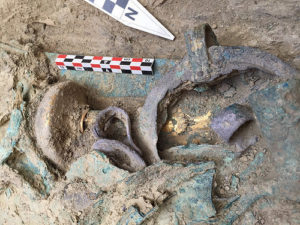
Found within the tomb: A meter-long slashing sword with an ivory handle covered in gold. Courtesy Department of Classics, University of Cincinnati
___________________________
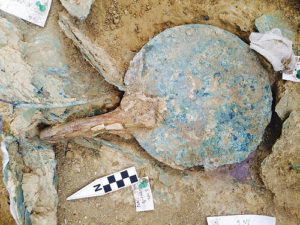
A bronze mirror with an ivory handle, found within the tomb. Courtesy Department of Classics, University of Cincinnati
___________________________
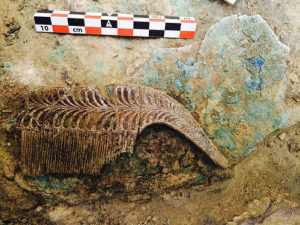
Ivory comb, one of six, found within the tomb. Courtesy Department of Classics, University of Cincinnati
___________________________
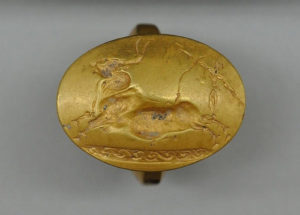
One of four solid gold rings found within the tomb. This one features a Cretan bull-jumping scene. Courtesy Department of Classics, University of Cincinnati
___________________________
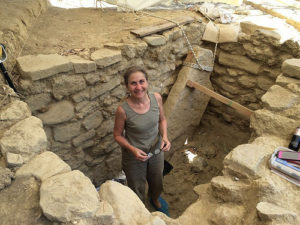
Shari Stocker stands within the excavated shaft tomb. Courtesy Department of Classics, University of Cincinnati
___________________________
Early Mycenaeans
Most significantly, the findings from the family tholos tombs and the Griffin Warrior tomb at Pylos have provided a tantalizing window on the early formative period of the Mycenaean civilization. “The new tombs are much larger than the Griffin Warrior grave and were used for multiple burials,” says Stocker. But the newly excavated tombs, thus far, have told us a story that is somewhat more obscure about the Mycenaean inhabitants at Pylos than what has been portrayed by the Griffin Warrior tomb. Speaking of the tholos tombs, continued Stocker, “they were certainly once as wealthy, but objects were removed in Mycenaean times and then they were looted after the collapse of the Mycenaean civilization, so we don’t know what they originally contained.” Nonetheless, she concludes, “it is clear from the discovery of the new tholos tombs that several elite families were vying for power and status already at the beginning of the Late Bronze Age. Eventually one individual, perhaps the warrior buried in the Griffin Warrior grave, was able to emerge with the sort of powers we imagine a Mycenaean wanax had, though we cannot be sure that the title was yet used, of course. We now understand that Pylos was a very important center of power in the formative stages of Mycenaean civilization and that members of the elite were receiving luxury imports from all over the Eastern Mediterranean and beyond.”*
To be sure, the recent discoveries at Pylos have changed perceptions about the sophistication of early Mycenaean art and craftsmanship. The artifacts recovered from both the Griffin Warrior shaft tomb and the tholos tombs have been particularly enlightening. But the finest example was exemplified by the combat scene seal stone (mentioned above) uncovered within the Griffin Warrior tomb, known as the Pylos Combat Agate. “What is fascinating is that the representation of the human body is at a level of detail and musculature that one doesn’t find again until the classical period of Greek art 1,000 years later,” said Davis.*** The style of the piece suggests a Minoan-Mycenaean connection or influence, though the skill that must have been required to produce it appears to exceed anything else known from that Minoan-Mycenaean time period. “It seems that the Minoans were producing art of the sort that no one ever imagined they were capable of producing,” continued Davis. “It shows that their ability and interest in representational art, particularly movement and human anatomy, is beyond what it was imagined to be. Combined with the stylized features, that itself is just extraordinary.”***
_________________________
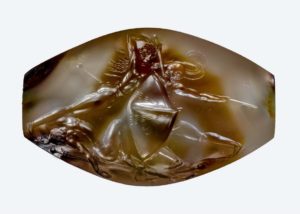
The tiny sealstone depicting warriors in battle measures just 1.4 inches across but contains incredible detail. Courtesy Department of Classics, University of Cincinnati
_________________________
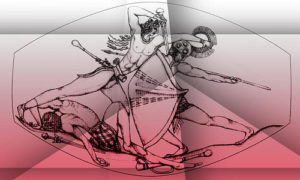
A digitally altered illustration of the seal found in the tomb of the Griffin Warrior. ourtesy Department of Classics, University of Cincinnati
_________________________
Moreover, regarding the Griffin Warrior tomb, it became clear that a substantial portion of the tomb’s objects actually originated in Crete, exhibiting a characteristic Minoan (3650 – 1450 B.C.) style and technique that differentiated from other objects more typically identified with mainland Greece in the 15th century B.C. Thus, given the nature of some of the key artifacts and the dating of the shaft tomb and its contents, archaeologists could see that there was an apparent Minoan connection here. Based on the dating of the tomb, “we are in the period subsequent to the eruption of the Thera volcano, in a time of intense interaction between the Greek mainland and the so-called Minoan “New Palaces,” says Stocker.
The Thera volcano is today a caldera remnant that forms the present-day island of Santorini (anciently known as Thera), a member of the Cyclades islands southeast of Greece. In the 17th century B.C., it was a fully formed volcano, the most prominent landmark of an island that was home to Akrotiri, a major Minoan city. But around 1600 B.C. the volcano’s massive eruption and destruction buried the Minoan presence there and profoundly affected the entire Minoan civilization, including their main settlements on Crete. The Minoans subsequently rebuilt their destroyed Cretan settlements and palaces at Knossos, Phaistos, Zakros and Malia. It was the time period of these new palaces that witnessed extensive contact and trade between Minoan Crete and the emerging Mycenaean civilization on mainland Greece. The influence can be seen, for example, with the evidence of Minoan handcrafted items on the Greek mainland, indicating a likelihood that the ruling houses of Mycenae were connected to the Minoan trade network. To possess goods of fine Minoan craftsmanship would be considered a sign of status, wealth and prestige. “This latest find is not the grave of the legendary King Nestor, who [according to Greek mythology] headed a contingent of Greek forces at Troy in Homer’s ‘Iliad’,” said Stocker. “Nor is it the grave of his father, Neleus. This find may be even more important because the warrior pre-dates the time of Nestor and Neleus by, perhaps, 200 or 300 years. That means he was likely an important figure at a time when this part of Greece was being indelibly shaped by close contact with Crete, Europe’s first advanced civilization.”* Thus the Griffin Warrior tomb, though rare in terms of its unlooted condition and the richness of its finds, may actually not have been atypical for the burial of a member of the elite structure of early Mycenaean times. By around 1500—1450 B.C., near the end of the early Mycenaean period and the time to which the shaft tomb is dated, archaeologists and historians know that a number of power centers had already emerged in the Greek southern mainland, dominated by a warrior elite society. Christofilis Maggidis, archaeologist and President of the Mycenaean Foundation and one of the world’s foremost authorities on Mycenaean culture, summarizes the Mycenaean world of this time:
“Rising to power was a long process through trade, diplomatic contacts, and constant warfare abroad and at home during the formative Early Mycenaean period (Late Helladic I-IIA/B, ca. 1650-1420/1410 BC). The Mycenaeans proved to be meticulous students: through increasing contacts with Minoan Crete, their trade horizons gradually expanded from the Balkans and Northern Europe to Egypt, the Levant, Cyprus, and Asia Minor. This gradual expansion is documented in the multicultural amalgam of stylistic, iconographic, technical elements and materials of the exquisite finds in the royal Shaft Graves at Mycenae (Minoan, Egyptian, European/Balkan, Hittite, and Helladic influences), the extensive corpus of foreign imports in Greece (orientalia and aegyptiaca), and the increasing Mycenaean exports abroad. Contemporary iconographical evidence (e.g. flotilla fresco from Akrotiri at Thera, silver Siege Rhyton from Grave Circle A at Mycenae) illustrate some of the early military achievements of the rising new power abroad: raiding jointly with the Minoan fleet foreign exotic lands (Egypt?), sieging and sacking foreign towns.”****
With this description, it is easy to see the fitting context of the man in the tomb. “Whoever he was,” speculates archaeological team co-leader Jack Davis, “he seems to have been celebrated for his trading or fighting on the nearby island of Crete and for his appreciation of the more sophisticated and delicate art of the Minoan civilization (found on Crete), with which he was buried.”* The Pylos Combat Agate seems to suggest both traits.
As recorded history and archaeology would testify, the Mycenaean warrior kings continued to dominate their expanding domain in the ensuing centuries, eventually conquering their own Minoan trading partners on Crete following the debilitating disruption of Minoan power and society, caused perhaps, at least in part, by the Thera eruption. Knossos and the other Minoan centers on Crete became predominantly Mycenaean, as evidenced by the archaeology and even the language. “At some point the palaces on Crete are destroyed, probably by Mycenaean invaders,” says Stocker, “and Greeks take control of Knossos and established an administration that kept records in Greek in the Linear B, as opposed to the old Linear A, script.”
__________________________
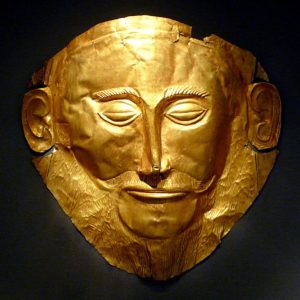
The famous “Mask of Agamemnon”, found in Tomb V in Mycenae by Heinrich Schliemann in 1876. Dated to the 16th century BC, it would have been an early Mycenaean work of art. Xuan Che, Wikimedia Commons, Creative Commons Attribution 2.0 Generic
__________________________
Work at Pylos is expected to continue. But the archaeology, as is the case with any major site, will involve much more than excavation and work in the field. Study and research related to the finds will go on, conceivably for decades. And equally important is the ongoing task to preserve what has been uncovered. Archaeological excavation is by its nature a destructive process, despite its careful and systematic process, and it exposes the remains to elements of the environment that would otherwise not be factors if the buried structures and objects had been left untouched. Stocker has been quick to emphasize this.
“We will look for funding to stabilize and conserve the monuments and collaborate with the [Greek] Ministry of Culture to help where we can.”
_________________________
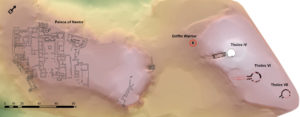
Map of the site shows the two family tombs (Tholos VI and Tholos VII), including the previously excavated Tholos IV tomb, in relation to the tomb of the Griffin Warrior and the Palace of Nestor. Denitsa Nenova/Courtesy Department of Classics, University of Cincinnati
_________________________
Although the tomb excavations and studies have been conducted through the Department of Classics, University of Cincinnati, with sponsorship from the American School of Classical Studies in Athens and permits from the Greek Ministry of Culture, research in the region of the tomb’s location has long been conducted under the auspices of the Pylos Regional Archaeological Project (PRAP), a project that has been underway for well over two decades. Undertaken as a multi-disciplinary endeavor to explore prehistoric and historic settlement in the area of the Bronze Age administrative center of the Palace of Nestor in the western Messenia region of Greece, the project has served to shed additional new light on a region that played a salient role in the prehistoric and Mycenaean history of Greece. Separate from PRAP, recent surveys and excavations in the area have also located and identified remains of houses of the Mycenaean palatial period, as well as remains of the Middle Bronze Age before the emergence of the Mycenaeans.
More information about the PRAP and other projects and organizations involved in the Messenia region can be obtained at the website.
Readers who wish to support the conservation and study of the shaft tomb discoveries may click here and enter Friends of Pylos in the comment box.
____________________________
*https://popular-archaeology.com/article/archaeologists-find-bronze-age-tombs-lined-with-gold/
**https://popular-archaeology.com/article/the-tomb-of-the-griffin-warrior/
***https://popular-archaeology.com/article/archaeologists-unearth-masterpiece-sealstone-in-greek-tomb/
****Christofilis Maggidis, Unearthing the City of Agamemnon, Popular Archaeology, June 5, 2014.
___________________________
Advertisement



